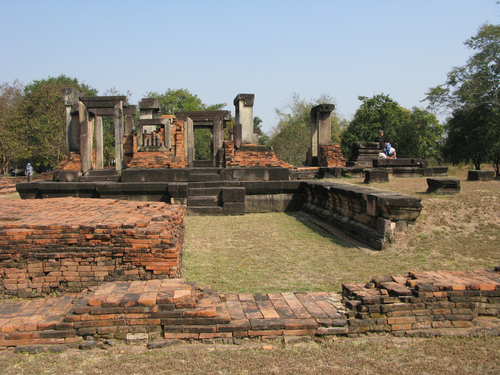ค้นหางานศิลปกรรม
ฐานข้อมูลศิลปกรรมในเอเชียตะวันออกเฉียงใต้
สถาปัตยกรรมปราสาทเมืองแขก
ปราสาทเมืองแขกมีขนาดค่อนข้างใหญ่ ก่อด้วยหินทรายและอิฐ แผนผังเป็นรูปสี่เหลี่ยมผืนผ้า หันหน้าไปทางทิศเหนือ สิ่งก่อสร้างสำคัญได้แก่ ปราสาทประธาน บรรณาลัย 2 หลัง ระเบียงคด ซุ้มประตูหรือโคปุระ กำแพงแก้ว สระน้ำ และปราสาทก่อด้วยอิฐขนาดเล็กลักษณะผังโบราณสถานแบ่งออกได้เป็น 3 ส่วน คือส่วนที่ 1 หรือส่วนในสุด ประกอบด้วยปราสาท 3 หลัง ก่อด้วยหินทรายและอิฐตั้งอยู่บนฐานเดียวกัน หัวหน้าไปทางทิศเหนือ เฉพาะองค์ปรางค์หรือปราสาทประธานมีมุขหรือมณฑปซึ่งมีลักษณะเป็นห้องต่อออกมาทางด้านหน้า มีบันไดขึ้นทั้งด้านหน้าและด้านข้างทั้ง 2 ข้าง พบฐานประติมากรรมหินทรายที่ครรภคฤหะของปราสาทประธานและปราสาทหลังด้านทิศตะวันออก อาคารทั้งสามหลังเหลือเพียงเฉพาะส่วนฐานและตัวอาคารบางส่วน รวมทั้งที่ปราสาทประธานยังคงหลงเหลือช่องหน้าต่างและลูกมะหวด เสาประดับกรอบประตู กรอบประตูหินทราย และทับหลังสลักภาพนารายณ์บรรทมสินธุ์ที่ด้านบนกรอบประตูหน้าสุดหรือส่วนมณฑปด้านข้างองค์ปรางค์ประธานมีฐานอาคารก่อด้วยอิฐ 2 หลัง อยู่ด้านซ้ายและขวาด้านละ 1 หลัง หันด้านหน้าเข้าสู่ปราสาทประธาน อาจเป็นวิหารหรือบรรณาลัย ในส่วนแรกนี้มีกำแพงแก้วก่อด้วยอิฐล้อมรอบ ทางด้านทิศตะวันออกของกำแพงมีอาคารอิฐผังสี่เหลี่ยมผืนผ้าก่อขนานยาวไปกับกำแพง อาคารหลังนี้มีประตูเข้าออกอยู่ด้านทิศตะวันตกและทิศเหนือ ยังคงหลงเหลือเสาประดับกรอบประตูอยู่ที่ประตูด้านทิศเหนือมีซุ้มประตูทางเข้าหรือโคปุระชั้นในอยู่ด้านเดียวคือด้านหน้าหรือด้านทิศเหนือ (มีช่องประตู 3 ช่อง) ที่ยังคงหลงเหลือกรอบประตูและเสาประดับกรอบประตูหินทราย นอกจากนี้ยังปรากฏฐานอาคารก่อด้วยอิฐอีก 2 หลังที่มุมกำแพงแก้วด้านหน้าของปราสาทประธาน ข้างโคปุระหรือซุ้มประตูชั้นในด้านหน้าหรือด้านทิศเหนือทั้ง 2 ด้าน ซ้ายและขวา โดยอาคารด้านขวามีทางเดินปูอิฐเชื่อมกับอาคารยาวที่ขนานไปกับกำแพงแก้วด้านทิศตะวันออกส่วนที่ 2 เป็นกำแพงชั้นนอก ซึ่งขุดเป็นสระเกือบจะล้อมรอบโบราณสถาน เว้นเพียงส่วนกลางด้านหน้า โดยใช้ดินที่ได้จากการขุดสระทำเป็นคันกำแพงล้อมรอบกำแพงแก้วและสระน้ำ ทางด้านทิศเหนือมีทางเดินเชื่อมกับส่วนในหรือส่วนที่หนึ่ง กำแพงชั้นนอกด้านหน้าหรือด้านทิศเหนือมีซุ้มประตูขนาดใหญ่หรือโคปุระชั้นนอกรูปกากบาท ตรงกับโคปุระชั้นใน (มีช่องประตู 3 ช่อง) ยังคงปรากฏช่องหน้าต่างและลูกมะหวดรวมทั้งกรอบประตูหินทรายส่วนที่ 3 อยู่นอกกำแพงชั้นนอกหรือส่วนที่สองออกมาทางด้านหน้าหรือด้านทิศเหนือ มีฐานอาคารก่อด้วยฐานก่อด้วยศิลาแลง หินทราย และอิฐ 2 หลัง ด้านซ้ายและขวาด้านละ 1 หลัง หันหน้าเข้าหากัน (อาคารหลังด้านขวาหันหน้าไปทางทิศตะวันตก ส่วนอาคารหลังด้านซ้ายหันหน้าไปทางทิศตะวันออก) ส่วนบนอาจจะสร้างด้วยไม้ ฐานอาคารทั้งสองหลังมีผังเป็นสี่เหลี่ยมมีมุขยื่นมาทางด้านหน้า ฐานสูง มีบันไดขึ้นสู่ด้านบนของฐานทั้ง 4 ด้าน มีกำแพงล้อมรอบ มีโคปุระที่ด้านหน้าและหลัง (ด้านหน้ามีขนาดใหญ่กว่า) ภายในห้องประธานของอาคารหลังด้านทิศตะวันตกมีฐานศิวลึงค์และโยนีหินทรายตั้งอยู่กลางห้อง เช่นเดียวกับอาคารหลังด้านทิศตะวันออกที่มีฐานประติมากรรมหินทรายตั้งอยู่กลางห้องประธาน จากการขุดค้นที่พบหลักฐานสำคัญ เช่น ศิวลึงค์ ฐานศิวลึงค์ หน้าบันสลักภาพอุมามเหศวร ทับหลังภาพพระอินทร์ทรงช้างเอราวัณ ทับหลังรูปพระนารายณ์บรรทมสินธุ์ ทับหลังรูปเทวดาประทับนั่งในซุ้มเหนือหน้ากาล ประติมากรรมโคนนทิ และจารึก 3 หลัก ทำให้สันนิษฐานได้ว่าศาสนสถานหลังนี้สร้างขึ้นเนื่องในศาสนาพราหมณ์ไศวนิกาย อายุราวปลายพุทธศตวรรษที่ 15 ถึงต้นพุทธศตวรรษที่ 16 ในศิลปะร่วมแบบเกาะแกร์-แปรรูป ส่วนจารึกระบุมหาศักราช 896 ตรงกับ พ.ศ.1517
สถาปัตยกรรมฐานเป็นชั้นที่ปราสาทเกาะแกร์
ปราสาทแห่งนี้ถือเป็นปราสาทบนฐานเป็นชั้นที่สูงและสง่างามที่สุดในศิลปะขอม เนื่องจากมีฐานซ้อนกันขึ้นไปถึง 7 ชั้น ด้านบนคงเคยประดิษฐานปราสาทประธาน 1 หลัง อนึ่ง ปราสาทบนฐานเป็นชั้นในศิลปะเกาะแกร์สามารถศึกษาเปรียบเทียบได้กับปราสาทปักษีจำกรงที่เมืองพระนครอีกหลังหนึ่ง
สถาปัตยกรรมซุ้มประตูที่ปราสาทเกาะแกร์
ปราสาทเกาะแกร์เป็นกลุ่มปราสาทที่ประกอบไปด้วยฐานเป็นชั้น (ปัจจุบันเรียกปราสาทธม) และปราสาทบนพื้นราบซึ่งประกอบไปด้วยกลุ่มปราสาทหลายหลังบนฐานเดียวกัน ด้านหน้าสุดปรากฏโคปุระขนาดใหญ่ซึ่งสร้างด้วยอิฐ ปราสาทแห่งนี้ถือเป็นพัฒนาการใหม่ทางด้านเทคนิคของปราสาทในศิลปะขอม เนื่องจากปราสาทที่สร้างด้วยอิฐส่วนมากมักมักเจาะประตูได้เพียงด้านเดียว แต่โคปุระของปราสาทเกาะแกร์กลับเจาะประตูได้ทั้งสองด้าน
สถาปัตยกรรมอาคารยาวมีหน้าจั่วสามเหลี่ยม ปราสาทเกาะแกร์
อาคารยาวๆของปราสาทเกาะแกร์ สร้างด้วยหินทั้งหลังแต่คงเคยมีหลังคาเป็นเครื่องไม้มุงกระเบื้อง ด้านหน้าประกอบด้วยหน้าจั่วสามเหลี่ยมซึ่งเลียนแบบมาจากอาคารเครื่องไม้ ที่น่าสนใจก็คือ ที่ปลายหน้าจั่วมีลายตกแต่งเป็นรูปขมวดม้วน ซึ่งอาจกลายมาจากงวงของมกรก็ได้ หน้าจั่วเช่นนี้จะปรากฏอีกกับปราสาทในศิลปะบันทายสรีและบาปวนบางหลัง เช่นปราสาทบันทายสรี ปราสาทพระวิหาร เป็นต้น อนึ่ง น่าสังเกต “รู” ที่หน้าบันซึ่งเคยเป็นเต้ารับแปของเครื่องไม้ซึ่งได้หายไปหมดสิ้นแล้ว
ประติมากรรมทับหลัง
ทับหลัง เป็นชิ้นส่วนของสถาปัตยกรรมที่พบในศิลปะเขมร โดยจะติดตั้งอยู่บนกรอบประตูทางเข้าเสมอทับหลังในสมัยพระโคจะมีลักษณะรับอิทธิพลมาจากศิลปะกุเลน ผ่านศิลปะชวา กล่าวคือการทำหน้ากาลอยู่กึ่งกลางด้านบนของท่อนพวงมาลัย ปลายทั้งสองข้างทำเป็นมกรหันหน้าออก ตามแบบซุ้มกาล-มกรตามศิลปะชวาภาคกลางแต่อย่างไรก็ตามในศิลปะพระโคสามารถทำเป็นประติมากรรมอื่นๆหันออกแทน ดังเช่นในภาพเป็นคชสิงห์ยืนอยู่บนแท่นท่อนพวงมาลัยมีการทำลายใบไม้ตั้งขึ้น ห้อยลงตามแบบศิลปะกุเลนลายดอกไม้กลมได้ปรับเปลี่ยนเป็นการแทรกภาพบุคคลอยู่ระหว่างท่อนพวงมาลัยรวมถึงภาพบุคคลที่แทรกอยู่ในส่วนของใบไม้ตกลงใต้ท่อนพวงมาลัยระหว่างช่องใบไม้ตกลงปรากฏการทำใบไม้สามเหลี่ยมแทรกอยู่ซึ่งแสดงให้เห็นถึงการพัฒนาต่อไปในศิลปะเกาะแกร์ด้านล่างของแผ่นทับหลังปรากฏการทำแถวดอกบัวซึ่งต่อมาจะเป็นรูปแบบที่ส่งให้กับทับหลังในสมัยศิลปะแปรรูป
ประติมากรรมพระวิษณุ ภายในปราสาทกระวาน
สลักภาพพระวิษณุ โดยเป็นพระวิษณุ 1 เศียร 8 กร รายล้อมด้วยเหล่าเทวดาและเทวสตรี ทางด้านรูปแบบศิลปะ พระวิษณุทรงสวมกระบังหน้า มีรัดเกล้าเป็นแนววงแหวนซ้อนลดหลั่นเป็นทรงกรวย มีการทำพระกร 8 กร นุ่งผ้าสมพตสั้น ระดับพระชานุ ผ้านุ่งมีริ้วทั้งผืน ด้านหน้ามีชายผ้าเป็นรูปวงโค้งขนาดใหญ่ ใต้แผ่นวงโค้งมีชายเข็มขัดเป็นแถบขนาดใหญ่ ถัดลงมามีชายสมอเรือซ้อนกัน 2 ชั้น โดยชายสมอด้านหลังทิ้งตกลงมาจนถึงพื้น
ประติมากรรมพระวิษณุตรีวิกรม ภายในปราสาทกระวาน
พระวิษณุทรงสวมกระบังหน้า มีรัดเกล้าเป็นแนววงแหวนซ้อนลดหลั่นเป็นทรงกรวย มี 4 กร ที่พระหัตถ์ขวาหน้าทรงถือดอกบัว พระหัตถ์ซ้ายหน้าทรงถือกระบอง พระหัตถ์ขวาหลังทรงถือจักร พระหัตถ์ซ้ายหลังทรงถือสังข์ นุ่งผ้าแบบสมพรตสั้นระดับพระชานุ ผ้านุ่งมีริ้วทั้งผืน ด้านหน้ามีชายผ้าเป็นรูปวงโค้งขนาดใหญ่ ใต้แผ่นวงโค้งมีชายเข็มขัดเป็นแถบขนาดใหญ่ ถัดลงมามีชายสมอเรือซ้อนกัน 2 ชั้น โดยชายสมอด้านหลังทิ้งตกลงมาจนถึงพื้น พระบาทข้างขวาทรงมีดอกบัวมารองรับ ปรากฏรูปสตรีถือดอกบัว ซึ่งหมายถึงพระภูมิเทวี ส่วนพระบาทข้างซ้ายประทับอยู่บนฐาน ที่ด้านซ้ายของรูปบุคคลตรงกลางมีรูปบุคคลขนาดเล็กนั่งพนมมืออยู่ น่าจะหมายถึงท้าวพลี
ประติมากรรมพระวิษณุทรงครุฑ ภายในปราสาทกระวาน
ภาพสลักพระวิษณุ ทรงสวมกระบังหน้า มีรัดเกล้าเป็นแนววงแหวนซ้อนลดหลั่นเป็นทรงกรวย มี 4 กร ที่พระหัตถ์ขวาหน้าทรงถือดอกบัว พระหัตถ์ซ้ายหน้าทรงถือกระบอง พระหัตถ์ขวาหลังทรงถือจักร พระหัตถ์ซ้ายหลังทรงถือสังข์ นุ่งผ้าแบบสมพรตสั้นระดับพระชานุ ผ้านุ่งมีริ้วทั้งผืน ด้านหน้ามีชายผ้าเป็นรูปวงโค้งขนาดใหญ่ ทรงประทับเหนือรูปบุคคลที่มีปีก และแผงขนนกรอบพระวรกาย สันนิษฐานว่าน่าจะเป็นครุฑ พาหนะของพระองค์วิษณุ


